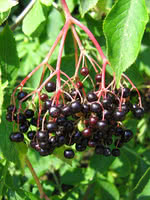Mon-Fri 9am - 5pm Mountain time
Silver Leaf Willow vs Black Elderberry
Sambucus canadensis
Salix alba var. sericea
NOT AVAILABLE THIS SEASON - MIGHT RETURN
NOT AVAILABLE THIS SEASON - MIGHT RETURN
Black Elderberry is a deciduous shrub native to eastern North America. You can plant this shrub in moist areas and it will help stabilize your soil. You can also use it on rural properties anywhere you'd use a lilac.
Black Elderberries are considered to be partially self-pollinating. So while they will still produce some berries without cross-pollination, planting with another variety will increase yields. Consider planting with Ranch Elderberry or Bob Gordon Elderberry.
Warning: the seeds, stems, leaves, roots, and uncooked berries of the Black Elderberry are poisonous to humans when eaten in quantity. You should cook the berries to make them safe for human consumption.
Silver Leaf Willow has orangish bark and long, silvery grey leaves. Bees and other insects are attracted to its flowers.
Popular as an ornamental tree for parks, it is also used as a shelterbelt species. It may not be as cold hardy as some of the other willow varieties, however.
Black Elderberry Quick Facts
Silver Leaf Willow Quick Facts
Toxicity: leaves, stems, and uncooked berries are poisonous to humans

